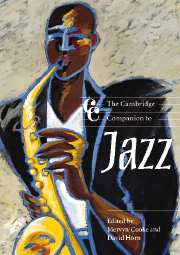Book contents
- Frontmatter
- The word jazz
- Part One Jazz times
- Part Two Jazz practices
- 5 Jazz as musical practice
- 6 Jazz as cultural practice
- 7 Jazz improvisation
- 8 Spontaneity and organisation
- 9 Jazz among the classics, and the case of Duke Ellington
- Part Three Jazz changes
- Part Four Jazz soundings
- Part Five Jazz takes
- Notes
- Works cited
- Principal musicians cited
- Index
6 - Jazz as cultural practice
from Part Two - Jazz practices
Published online by Cambridge University Press: 28 September 2011
- Frontmatter
- The word jazz
- Part One Jazz times
- Part Two Jazz practices
- 5 Jazz as musical practice
- 6 Jazz as cultural practice
- 7 Jazz improvisation
- 8 Spontaneity and organisation
- 9 Jazz among the classics, and the case of Duke Ellington
- Part Three Jazz changes
- Part Four Jazz soundings
- Part Five Jazz takes
- Notes
- Works cited
- Principal musicians cited
- Index
Summary
Since jazz emerged from its geographical origins it has travelled back and forth across the disputed terrain between high and low culture, variously located as folk, popular, art music and permutations. Its shifting position makes it a particularly instructive vehicle through which to study the matrix of cultural politics, the balances of power that determine which cultural forms carry authority. The migrations of jazz within musical politics and aesthetics depend upon negotiations between text (the particular jazz performance) and context (the physical and cultural space within which it is situated). The Eurocentric arbitration of musical value by the end of the nineteenth century was predicated on the stability of the musical text and of its relationship with context. Jazz appeared to demolish this model. As aurally based improvisation, in performance the ‘text’ evaded fixity, and the sites and conditions of performance blurred the distinction between art and social practice, music and noise. Even preserved on a sound recording, its formal components were scarcely intelligible in established musical terms such as background–foreground, melody–harmony and structural coherence. Jazz was a site of unruliness.
Jazz categorisations
The rapid international diaspora of jazz (see Chapter 2) meant that it could not be ignored; jazz was arguably the most pervasively influential development in twentieth-century music. Apart from the particular musical forms and practices in which it has been seminal, it was the most widespread musical vehicle of the progressive thrust into the experience of modernity in the early twentieth century, in such matters as gender, mass mediations and technological innovation.
- Type
- Chapter
- Information
- The Cambridge Companion to Jazz , pp. 96 - 113Publisher: Cambridge University PressPrint publication year: 2003
- 4
- Cited by



